Screening and identification of susceptibility genes for cervical cancer via bioinformatics analysis and the construction of an mitophagy-related genes diagnostic model
- PMID: 39294534
- PMCID: PMC11410911
- DOI: 10.1007/s00432-024-05952-7
Screening and identification of susceptibility genes for cervical cancer via bioinformatics analysis and the construction of an mitophagy-related genes diagnostic model
Retraction in
-
Retraction Note: Screening and identification of susceptibility genes for cervical cancer via bioinformatics analysis and the construction of an mitophagy-related genes diagnostic model.J Cancer Res Clin Oncol. 2025 Jan 23;151(1):42. doi: 10.1007/s00432-025-06100-5. J Cancer Res Clin Oncol. 2025. PMID: 39843805 Free PMC article. No abstract available.
Abstract
Purpose: This study aims to utilize bioinformatics methods to systematically screen and identify susceptibility genes for cervical cancer, as well as to construct and validate an mitophagy-related genes (MRGs) diagnostic model. The objective is to increase the understanding of the disease's pathogenesis and improve early diagnosis and treatment.
Method: We initially collected a large amount of genomic data, including gene expression profile and single nucleotide polymorphism (SNP) data, from the control group and Cervical cancer (CC) patients. Through bioinformatics analysis, which employs methods such as differential gene expression analysis and pathway enrichment analysis, we identified a set of candidate susceptibility genes associated with cervical cancer.
Results: MRGs were extracted from single-cell RNA sequencing data, and a network graph was constructed on the basis of intercellular interaction data. Furthermore, using machine learning algorithms, we constructed a clinical prognostic model and validated and optimized it via extensive clinical data. Through bioinformatics analysis, we successfully identified a group of genes whose expression significantly differed during the development of CC and revealed the biological pathways in which these genes are involved. Moreover, our constructed clinical prognostic model demonstrated excellent performance in the validation phase, accurately predicting the clinical prognosis of patients.
Conclusion: This study delves into the susceptibility genes of cervical cancer through bioinformatics approaches and successfully builds a reliable clinical prognostic model. This study not only helps uncover potential pathogenic mechanisms of cervical cancer but also provides new directions for early diagnosis and treatment of the disease.
Keywords: Bioinformatics analysis; Cervical cancer; Clinical prognosis model; Susceptibility genes.
© 2024. The Author(s).
Conflict of interest statement
The author did not encounter any conflicts throughout the preparation of the article.
Figures
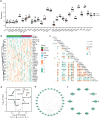



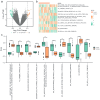


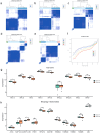


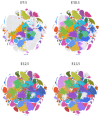
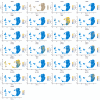


Similar articles
-
Identification of a disulfidptosis-related genes signature for diagnostic and immune infiltration characteristics in cervical cancer.PLoS One. 2025 Apr 30;20(4):e0322387. doi: 10.1371/journal.pone.0322387. eCollection 2025. PLoS One. 2025. PMID: 40305445 Free PMC article.
-
Screening of cervical cancer-related hub genes based on comprehensive bioinformatics analysis.Cancer Biomark. 2021;32(3):303-315. doi: 10.3233/CBM-203262. Cancer Biomark. 2021. PMID: 34151839
-
Bioinformatics and cheminformatics approaches to identify pathways, molecular mechanisms and drug substances related to genetic basis of cervical cancer.J Biomol Struct Dyn. 2023;41(23):14232-14247. doi: 10.1080/07391102.2023.2179542. Epub 2023 Feb 28. J Biomol Struct Dyn. 2023. PMID: 36852684
-
Identification of a mitophagy-related gene signature for predicting overall survival and response to immunotherapy in rectal cancer.BMC Cancer. 2025 Jan 6;25(1):15. doi: 10.1186/s12885-024-13412-1. BMC Cancer. 2025. PMID: 39762799 Free PMC article.
-
Bioinformatics Screening of Potential Biomarkers from mRNA Expression Profiles to Discover Drug Targets and Agents for Cervical Cancer.Int J Mol Sci. 2022 Apr 2;23(7):3968. doi: 10.3390/ijms23073968. Int J Mol Sci. 2022. PMID: 35409328 Free PMC article.
Cited by
-
Construction and validation of a chemokine-related gene signature associated with prognosis, clinical significance, and immune microenvironment characteristics in cervical cancer.Discov Oncol. 2025 Jun 15;16(1):1114. doi: 10.1007/s12672-025-02973-7. Discov Oncol. 2025. PMID: 40517358 Free PMC article.
References
-
- Andalib K, Rahman MH, Habib A (2023) Bioinformatics and cheminformatics approaches to identify pathways, molecular mechanisms and drug substances related to genetic basis of cervical cancer. J Biomol Struct Dyn 41:14232–14247. 10.1080/07391102.2023.2179542 - PubMed
-
- Bhattacharjee R, Das SS, Biswal SS, Nath A, Das D, Basu A et al (2022) Mechanistic role of HPV-associated early proteins in cervical cancer: molecular pathways and targeted therapeutic strategies. Crit Rev Oncol Hemat 174:103675. 10.1016/j.critrevonc.2022.103675 - PubMed
-
- Ding Y, Wu X, Yang X (2023) Identification of miRNAs and target genes associated with lymph node metastasis in cervical cancer using bioinformatics analysis. Toxicol Mech Method 33:625–635. 10.1080/15376516.2023.2207644 - PubMed

